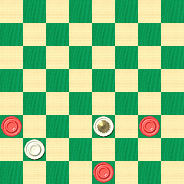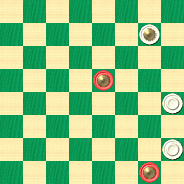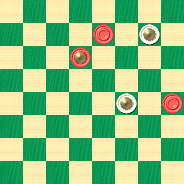The Checker Maven
Jump to navigationCashing In On The Win

Earlier, we presented a series of lessons on man-down draws. Today, we'll extend that series by showing two examples on winning a won game and one more on pulling off a man-down draw.
It's more than a little interesting and instructive to look at man-up positions that ought to be a win, but aren't all that easy to carry out. Here's the first one, credited to E. McMillan. Black is ahead in numbers, but has three single men who haven't moved very far, while White has one king and may soon have another.
WHITE

BLACK
Black to Play and Win
B:WK10,8:B12,9,2.
Now, let's look at a position put forth long ago by the legendary Joshua Sturges. Here we're to draw with a man down. Note that some key elements are in place: Black, though inferior in numbers, has two kings to White's one, and the White men are on the edge of the board.
WHITE

BLACK
Black to Play and Draw
B:WK25,13,5:BK18,K1.
In our final example, Black is ahead in the piece count but has one king against White's two, and White seems to have chances at obtaining Payne's Single Corner Draw.
C. ADAMSON
WHITE

BLACK
Black to Play and Win
B:WK25,K14:B26,K23,13.
After you've worked through these problems, click on Read More for Ben Boland's detailed solutions, example games, and copious notes.![]()
Solutions
Here are the solutions as published by Ben Boland.
McMillan
12-16-A, 8-3, 16-19, 3-8, 19-23, 10-15, 23-26, 15-18, 26-31-B, 8-11, 31-27, 11-15, 2-7 18-22, 9-14, 22-25, 14-17, 25-21, 17-22, 15-18, 22-26, 18-15, 27-23, 21-17, 26-31, 17-14, 31-27-C, 14-9, 27-32, 9-14, 32-28. Black Wins.
Game: 11-15 22-18, 15-22, 25-18, 12-16, 29-25, 9-13, 18-15, 10-19, 24-15, 16-20, 25-22 8-12, 23-18, 7-10, 27-24, 20-27, 31-24, 10-19, 24-15, 12-16, 28-24, 16-20, 21-17, 20-27, 32-23, 3-7, 30-25, 4-8, 25-21, 8-12, 23-19, 7-10, 17-14, 10-17, 21-14, 13-17, 22-13, 6-9, 13-6, 1-17, 15-11, 17-21, 11-8, 21-25, 26-23, 25-30, 18-15, 30-26, 15-11, 5-9, 8-3, 26-31, 23-18, 31-26, 19-15, 26-23, 11-8, 23-14, 15-10, 14-7, 3-10. Forms above position. M. Brown vs. J. P. Reed, Game No. 14, American Checker Review, Vol. 2, Mar. 15, 1889.
A---9-13 10-14, 12-16, 8-3, 16-19, 3-8, 19-24*---i, 8-11, 24-27, 11-15, 27-31, 15-18, 31-26, 14-10, 26-31, 10-14, 31-27, 18-22, 27-23, 22-25, 23-26, 14-10, 26-23, 10-14 23-19-D, 14-18, 2-7, 18-22. Payne's Draw. Brown vs. Reed.
B---26-30, 18-22, 9-14-E, 8-11, 2-6, 11-16, 6-9, 16-19, now same as Problem No. 50, by W. Gardner, Gould's Problem Book, after first move, colors reversed, continue; 9-13, 19-23, 14-17, 23-27, 17-26, 27-31, 13-17. Drawn. J. P. Reed.
C---This is now an ending by R. D. Petterson; Black---Kings 18, 32, and White---20, 26 King 7. White to Play and Win: 7-11, 32-28, 20-16, 28-24, 16-12, 24-19, 12-8, 19-24, 8-3, 24-19, 3-7, 19-24, 7-2, 24-19, 2-6, 19-24, 11-7, 24-19, 7-10, now same as at C, colors reversed. This was first published in the Leed's Mercury Supplement, about 1888, it may be found as No. 44 in Dunne's Guide. This position stumped "the old timers." H. D. Lyman in American Checker Review, Vol. 4, 1892, as No. 20, gave it as a draw. Compare this position to Wray's Position where the move is different and the result is a draw.
D---2-7, 25-22, 7-11, 22-18*, 23-19, 18-22*, 19-15, 14-17*, 15-10, 17-21. Drawn. J. P. Reed.
E---2-7, 8-12, 7-11, 12-8, 11-16, 8-11, 16-20, 11-15, 20-24, 15-10-F, 24-27, 10-6, 9-13, 6-9, 27-31, 9-14, 30-26, 14-17. Payne's Draw.
F---15-18, 24-27, 22-17, now we have Problem No. 124, by J. P. Reed, colors reversed, American Checker Review, Vol. 2, Sept. 15, 1889, continue; 30-26, 18-22, 26-23, 17-13, 9-14, 13-9, 27-32. Black Wins. In A. C. R. Nov. 1889, John T. Hennigan shows how he got the same ending from a "Black Doctor" Game.
i---Editor's Note: We are not sure why this move is starred by Mr. Boland, but computer analysis (Cake Manchester) shows this to be the move that concedes the draw; 19-23 would still win for Black.
The above position was first published as No. 13 by J. P. Reed, in the American Checker Review, Mar. 1889. The terms were "Black to Move and White to Draw." The following note was added: "We desire our Lynx-eyed friends to give this position careful attention and find a flaw, if possible. We found no answer.
E. McMillan gave the above play in No. 3847 in the Melbourne Weekly Times, July 25, 1936. It was submitted to correct Problem No. 19 in the Third American Tourney Book.
Compare Note C to Wray's Position, Page 55.
Sturges
18-14, 25-22, 14-10, 22-18, 10-6. Drawn
Game: 9-14, 22-17, 11-15, 23-19, 8-11, 25-22, 11-16, 24-20, 16-23, 27-11, 7-16, 20-11, 5-9, 26-23, 3-7, 28-24, 7-16, 24-20, 16-19, 23-16, 12-19, 17-13 4-8 20-16, 8-11, 16-7, 2-11, 22-17, 19-23, 29-25, 11-15, 31-26, 14-18, 26-19, 15-24, 17-14, 10-17, 21-5, 18-23, 25-21, 24-27, 21-17, 27-31, 30-25, 31-26, 32-28, 23-27, 25-21, 26-23, 17-14, 23-18, 14-9, 6-10, 9-6, 10-14, 6-2, 18-15, 2-7, 15-10, 7-11, 10-6, 28-24, 27-31, 24-19, 31-27, 19-16, 27-23, 16-12, 23-18, 12-8-A, 14-17, 21-14, 18-9, 8-3, 9-14, 11-7, 6-2, 7-10, 14-7, 3-10, 2-6, 10-7, 6-2, 7-11, 2-6, 11-16, 6-2, 16-19, 2-6, 19-23, 6-2, 23-18, 2-6. Same as above at end. J. Murray.
A---The above started as Game No. 778, Draughts World, Vol. 10, 1897. It was brought to this point through play by Messrs. Veal, Thirkell and Ferguson. Then came James Murray, Vol. 12, Problem 666, and continued to draw as above.
Position from game has a man on 1 instead of a King as in diagram, but play is the same. The above position is No. 23, in Sturges' Critical Positions, 1808.
Compare to Payne's, with the man on 13 a King, it wins, see Page 20.
Avoiding Payne's Draw
26-31, 25-22, 31-27, 14-10, 27-24, 10-14, 24-20, 14-10, 23-19, 10-14, 19-15, 22-25, 20-16, 25-22, 16-12, 22-25, 12-8, 25-22, 8-3, 14-9, 15-10. Black Wins.
Game: 11-15, 22-18, 15-22, 26-17, 12-16, 17-14, 9-18, 23-14, 10-17, 21-14, 6-9, 30-26, 9-18, 26-23, 1-6, 23-14, 6-9, 24-19, 16-23, 27-18, 8-11, 31-26, 3-8, 32-27, 11-15, 18-11, 8-15, 26-23, 9-18, 23-14, 2-6, 27-23, 15-18, 23-19, 18-23, 19-15, 23-26, 25-22, 26-30, 22-18, 30-26, 28-24, 26-22, 15-10, 22-15, 10-1, 15-18, 24-19, 18-9, 19-16, 7-10, 16-11, 9-14, 11-7, 10-15, 7-2, 14-10, 2-6, 4-8, 29-25, 8-11, 25-22, 10-7, 6-2, 15-19, 22-18, 5-9, 1-6, 9-13, 18-14, 19-24, 6-10, 7-3, 14-9, 24-28, 10-14, 28-32, 9-6, 11-16, 6-1, 3-8, 1-6, 8-11, 6-10, 16-19, 2-6, 19-23, 6-9, 32-27, 9-6, 23-26, 14-18, 26-31, 18-22, 27-23, 10-14, 11-15, 6-1, 23-26, 22-25, 31-27, 14-10, 15-6, 1-10, 27-23, 10-14. Forms above position, with man on 26 a king. R. Martins vs. J. Wyllie, Game No. 31, in their match of 1867.
The above setting was given as position No. 69, in the Draught Board, January 1, 1870. It was given to correct the above game which was left as drawn. In the game the man on 26 is a king, but the play is the same.
"Pushing a Bit of Wood!" How many times does one hear the question asked, 'What delight do you find in pushing a Bit of Wood over Black and White Squares?' The happiness and pleasure found therein is that in moving forward one of these little discs we see stratagems, ruses, and combinations sometimes marvellous, and which it is impossible for you to perceive, you who do not understand the game, or are a novice at it. To comprehend it, to love and admire it, one must attain a certain degree of skill at the game.
Editor's Note: Apologizing for past failings, in this article we've been careful to distinguish what we mean by Payne's Draw. Here, we refer to Payne's Single Corner Draw, which is often just called Payne's Draw, not to be confused with Payne's Double Corner Draw, which was covered in a previous lesson.
You can email the Webmaster with comments on this article.
